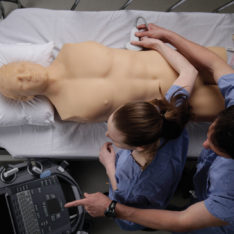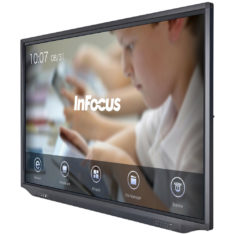CAE Lucina is the only wireless childbirth simulator with validated, integrated maternal-fetal physiology and interchangeable static cervices to train on all the stages of delivery and the rare emergency scenario. Lucina brings an impressive blend of features to the market including a more realistic and controllable birthing process, better articulation for labor and delivery maneuvers, and predicted APGAR scores based on the integrated maternal-fetal physiology. From normal delivery and breech birth to shoulder dystocia and eclampsia, Lucina does it all. With 5 pre-configured Simulated Clinical Experiences (SCEs), Lucina allows instructors to increase throughput and manage multiple demands effortlessly.
Lucina
CAE Lucina allows clinicians to practice pre-partum assessment, labor and delivery, emergency care and transport all within one wireless patient simulator. With modeled and validated physiology that is integrated with the fetal physiology, Lucina responds automatically to obstetric maneuvers and clinical
interventions. Lucina offers the most complete training in shoulder dystocia management and supports mechanical ventilation. With the addition of the Female Patient Module, Lucina easily transforms into a non-gravid patient for practice of emergency scenarios.
Obstetrical
• Integrated maternal-fetal physiological modeling
• Realistic and consistent birth canal and vulva/
perineum support with accurate fetal descent
and rotation
• Multiple birthing positions: lithotomy, sitting
and all fours
• Rectal suppository administration
Prepartum
• Vaginal examinations can be performed for
evaluation of the cervix, fetal station, and position
• Static cervices represent various stages of
dilation from closed to 5cm, and effacement
from 0 to 90%
• Leopold’s Maneuvers can be performed
• Epidural port with infusion and aspiration
Intrapartum
• Realistic palpable uterine contractions
• Controllable rate and duration of contractions
• Trendelenburg position with detection
• Left lateral tilt with detection
• Vertex and breech delivery
• McRoberts Maneuver with observable pelvic tilt
• Suprapubic pressure support and detection
with palpable symphysis pubis
• Supports delivery of posterior arm during
shoulder dystocia
• Zavanelli maneuver with detection
• C-section team training support
• Rotation of anterior and posterior shoulder is
detected in resolving shoulder dystocia (Rubin II
and Woods’ Screw Maneuvers)
• Forceps application
• Vacuum extraction without fetal cap
• Episiotomy
• Intact/fragmented placenta with realistic color,
texture and flexibility
Fetus
• Fetal heart sounds–5-locations based on fetal
presentation
• Articulated fetal body neck (with lateral neck
movement), shoulders, elbows, hips, and knees
• Clinically accurate fetal size with tactile realism–
5th percentile on the WHO growth chart
• Fetal neck traction sensing
• Palpable fontanel and sagittal suture
• Fetal airway suctioning
• Programmable audible cry upon delivery
• Predicted 1-minute and 5-minute APGAR scores
based on venous and arterial blood gas values
• Umbilical cord that can be cut and clamped
Postpartum
• Postpartum hemorrhaging, including Class III
hemorrhage
• Contracted and boggy uterus
• Bimanual compression and uterine massage
• Uterine blood released upon massage
• Inverted postpartum uterus
• Uterine reversion (optional uterine inversion
module)
• Intrauterine balloon insertion
Key Features
Airway and Breathing
• Realistic upper airway
• Advanced lungs with mechanical ventilation support
and different ventilation modes (CMV, SIMV)
• Airway management and ventilation
• Supports endotracheal tubes, nasal-pharyngeal
and oropharyngeal airways
• Spontaneous breathing
• Bag-valve-mask ventilation
• Lung auscultation: anterior and posterior with
individual lung control
• Spontaneous chest excursion
• Positive pressure ventilation
Circulatory System
• ECG monitoring posts and interface with real ECG
monitor
• 12-lead dynamic ECG display
• Dynamic bilateral pulses: carotid, radial, brachial,
and dorsalis pedis; pulse strength can be controlled
Cardiovascular
• Correct hand placement detection
• Advanced CPR analysis (compression depth and rate,
chest recoil, compression fraction, ventilation volume
and rate)
• Compliant with 2015 AHA guidelines
• Pacing, cardioversion and defibrillation
• NIBP – both audible and palpable
• Heart sounds
Nervous System
• Seizure is simulated with rhythmic movement of
arms and rapid blinking fraction
• SymEyes display patient symptoms and conditions,
including jaundice, hemorrhage, keyhole
pupil, cataracts and bloodshot or droopy eyes
• Blinking, panning and reactive eyes with
multiple settings
• Speech: live and pre-recorded
Fluids
• Postpartum bleeding tank (2.0 L)
• Bilateral IV arms
• Urinary catheterization
• Epidural infusion
Sounds
• 2-way voice communication
Standard Equipment:
Wireless maternal manikin
Birthing fetus
Fetus to support Leopold’s maneuvers
2 abdomens (1 for delivery, 1 for
prepartum and postpartum)
Postpartum uterus
Static cervices for vaginal exams
Instructor’s workstation with 2
device options
Müse operating software
TouchPro wireless emulated patient monitor
3 patient profiles
10 Simulated Clinical Experiences (SCEs)
A normal delivery
An instrumental vaginal delivery
Fetal tachycardia due to maternal pyrexia
Breech delivery
Fetal central nervous system depression
by narcotics given to the mother
Shoulder dystocia
Major post-partum hemorrhage due to
uterine atony
Maternal cardio-respiratory arrest
Eclampsia
Umbilical cord prolapse
4 SCE development licenses
CAE Assurance value plan with customer
and technical support, Training for
Life™ and option to renew




